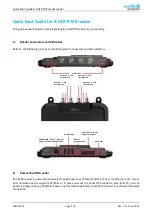
Page 39 of 58
POS-123-*-2030
FAULT
CAUSE / SOLUTION
ENABLE is active, the
READY LED is flashing.
The flashing READY LED signals that a fault has been detected by the module. The
fault could be:
A broken cable or no signal at the input (PIN 13 or PIN 14), if
4… 20 mA signals
are parameterized.
A broken cable or incorrect cabling to the solenoids (in the P version only).
SSI sensor
Internal data error: press the command/SAVE button to delete the data error. The
system reloads the DEFAULT data.
With the WPC-300 operating program the fault can be localized directly via the
monitor.
ENABLE is active; the
READY LED is on, the
system moves to an
end position.
The control circuit polarity is incorrect. The polarity can be changed with the POL
command or by reversing the connections to PIN 15 and PIN 16.
ENABLE is active, the
READY LED is on, the
STATUS LED is not on,
the system moves to
the target position but
doesn’t reach it
(positioning error).
Serious positioning errors can result from incorrect parameterization or incorrect
system design.
Is the cylinder position specified correctly?
Are the deceleration strokes correct (to start the system the deceleration
distances should be set to approx.
20… 25 % of the cylinder position
16
)?
Is the valve a zero lapped control valve or a standard proportional valve?
In the case of a proportional valve, the valve overlap which may be present
should be compensated for with the MIN parameters. Typical values are to be
found in the valve data sheet.
ENABLE is active, the
READY LED is on, and
the system oscillates on
the target.
The system is working and also actuating the valve.
Various potential problems could be:
The parameterization is not yet adjusted to the system (gain too high).
There is severe interference on the power supply.
Very long sensor cables (> 40 m) and sensor signal interference.
The MIN setting to compensate the valve overlap is too high.
As a basic principle, the parameterization of the sensor data and the controller
settings must be carried out first (before switching on). An incorrect demand is
equivalent to incorrect system design which then leads to incorrect operation. If the
system oscillates, the gain should first be reduced (longer deceleration distances for
D:A and D:B) and in the case of overlapped valves the MIN parameter should also
be reduced.
Speed too low
The drive may be able to move to position but the speed is too low.
Check the control signal to the valve.
Via the integrated oscilloscope (U variable).
Measure the signal to the valve with an external oscilloscope / voltmeter.
If the control is within the range of ± 100 % (± 10 V), the fault must be sought in
the hydraulics.
If the control signal is relatively low, the following points should be checked:
Is the internal/external speed signal limiting the speed?
Which setting has been specified for the deceleration distance in relation to
the POSITION?
Speed too high
The drive should move to position. The drive moves in and out too fast leading to
uncontrolled behavior. Reducing the speed (MAX or VELO parameter) has very little
or no effect.
The hydraulic system is over-sized. The entire parameterization of the movement
cycle cannot be reproduced (overlap and deceleration distance settings)
16
The stability criterion of the hydraulic axes must be taken into account.
















































